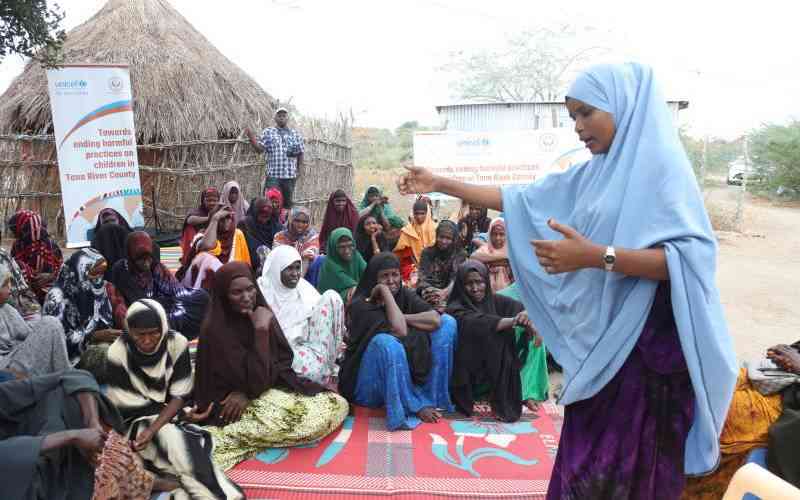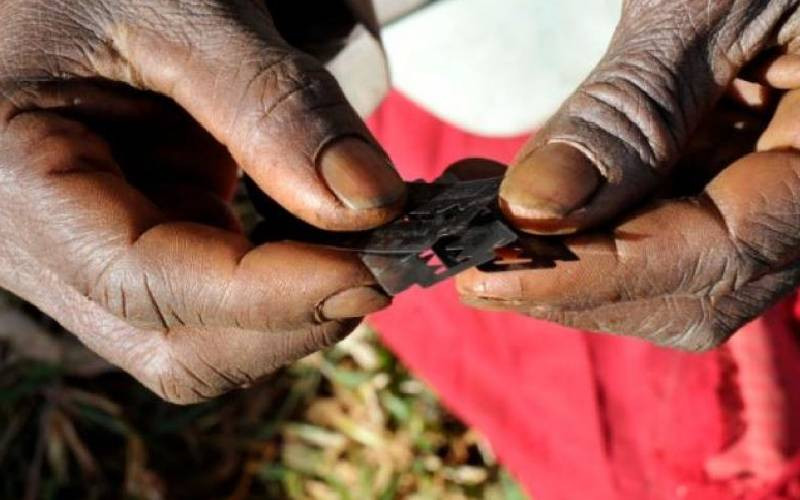They say life begins at 40. On March 3, Evangeline Mukami turned 40. A week earlier, on February 26, she had successfully undergone surgery to correct damages suffered from Female Genital Mutilation (FGM).
“The surgery was successful. It gave me the opportunity to enjoy intimacy,” she says. You heard that right: ‘Intimacy’.
Mukami recalls vividly the day she underwent FGM.
She says: “It was early in the morning. I was told to sit on banana leaves. I was held down by women – some of them my aunties.”
“Someone lifted my left leg, another my right, another my arms and another my head. They pinned me down. I couldn’t move a muscle.
“Then I felt a sharp pain in my genitalia. It was a nurse injecting me with anaesthesia. The cut followed. There was blood everywhere.”
Mukami says she was “very young; probably 10 or so years old.”
Two months later, her wound had healed and life went back to normal. However, when she was in class 6, something began to grow from the scar.
She did not pay it much attention until it ballooned to the size of a golf ball.
“When I joined campus in 2002, I came to the full realisation that it was not normal: that something was wrong,” she says. She attended a free medical camp that resulted in free surgery to remove the growth – doctors had determined that it was a ‘cyst’.
The cyst grew back again
She cobbled up some money from doing small businesses and paid for a second surgery.
The cyst still came back. In total, by last year, she had undergone four surgeries to get rid of the cysts.
“Then I met Bernadette Loloju – the CEO of Anti-FGM Board. She introduced me to Dr Adan Abdulahi.”
Dr Adan is a plastic, aesthetic and reconstructive surgeon. He runs Platinum Surgery Centre (PSC) on Argwings Kodhek Road in Nairobi. He also teaches surgery at the University of Nairobi.
“Every month, we perform approximately 10 surgeries on women who have undergone FGM. In the last year, we did 110,” he says.
The surgery, he adds, is aimed at removing scarring and cysts that are synonymous with FGM. Dr Adan also performs a ‘miraculous’ procedure to ‘bring back’ the clitoris; an organ that the doctor says is critical to women’s ability to enjoy sex. He describes the clitoris as containing “billions of nerve endings”.
Painful intercourse
FGM is categorised from type 1 to type 4: with ascending degree of damage. But all of them involve cutting off a section, or the whole, of the clitoris.
Dr Joachim Osur, a medical doctor who has specialised in Human Sexology, says that the clitoris is the most sensitive sex organ on a woman.
Dr Osur says: “The mechanicals of sexual intercourse proceeds in a manner that the woman is first able to lubricate: which should happen naturally.
“Sensitivity of the clitoris almost certainly ensures lubrication. Without it, the woman either takes longer to lubricate or is not able to.
“Which means that intercourse for them is painful and not pleasurable. Due to FGM, there are women who will never know what an orgasm feels like.”
The primary reason people get married is intimacy, says Sheila Wachira, a counsellor and expert on marriage and relationships. “Each of the parties is expecting to be satisfied sexually,” she says.
This state of incomplete intimacy, she says, would eventually cause strife between couples.
Indeed, this is the predicament Mukami found herself in.
Stay informed. Subscribe to our newsletter
Marriage was on the rocks
“This year, around the time I was having the surgery, my husband and I were going our separate ways. Our marriage was on the rocks,” she says.
A lot of their disagreements, she says, emanated from the fact that the FGM scars had strangled her self-esteem and denied her the ability to enjoy intimacy.
“The cyst was uncomfortable. I felt unattractive. I did not look forward to intimacy. I used all the tricks to avoid sex.
“Sometimes, I would stay up late and wait till my husband was asleep before sneaking into bed. Other times, I would start a fight; because once we fought I knew he wouldn’t ask for sex. At some point, he got fed up and just said, ‘I can’t keep begging for sex,’” she narrates.
Whenever the couple got intimate, it felt like an obligation to her. All she felt was pain and discomfort.
Since surgery, life in the bedroom just got tantalising for Mukami, she says. The couple has since patched up.
“I am now enjoying intimacy with my husband. In a way, the surgery saved our marriage,” she says.
Dr Adan says: “For Mukami, the surgery involved taking out the cyst, removing scar tissue and propping up (to expose) buried clitoral tissue to the surface.”
The clitoris is an extensive organ: what is visible on the surface is, literally, the tip of the iceberg.
“It is approximately 10cm long. A big chunk is buried in the flesh. The surgery is done in a way that allows the buried part to replace what was cut,” Dr Adan says.
Healing after surgery takes two months
The surgery, he notes, does not restore the woman’s body to its original form. “Depending on the type and extent of FGM, the surgery gives back women the ability to enjoy sex to different degrees,” he says.
The surgery costs between Sh120,000 and Sh150,000. Healing after surgery takes two months – a period when the patient cannot engage in sex.
“From our data, we can report 92 per cent sensitivity increased and about 55 per cent orgasm achieved.”
Dr Adan, however, warns that surgery has to go along with psychotherapy. “Nearly all FGM victims I have operated reveal that they don’t feel whole; that they feel embarrassed; that they do not have confidence.”
Mukami too got herself a counsellor. “I still go for sessions whenever I feel stressed,” she says.
At 40, life has truly begun for this mother of three. For the first time, she is enjoying intimacy in her marriage.
She is now an anti-FGM campaigner. “The cost of doing the surgery is high. My prayer is that it becomes available to FGM victims who would want it,” she says.
She is also admonishing the government to fight FGM even harder.
 The Standard Group Plc is a
multi-media organization with investments in media platforms spanning newspaper
print operations, television, radio broadcasting, digital and online services. The
Standard Group is recognized as a leading multi-media house in Kenya with a key
influence in matters of national and international interest.
The Standard Group Plc is a
multi-media organization with investments in media platforms spanning newspaper
print operations, television, radio broadcasting, digital and online services. The
Standard Group is recognized as a leading multi-media house in Kenya with a key
influence in matters of national and international interest.
 The Standard Group Plc is a
multi-media organization with investments in media platforms spanning newspaper
print operations, television, radio broadcasting, digital and online services. The
Standard Group is recognized as a leading multi-media house in Kenya with a key
influence in matters of national and international interest.
The Standard Group Plc is a
multi-media organization with investments in media platforms spanning newspaper
print operations, television, radio broadcasting, digital and online services. The
Standard Group is recognized as a leading multi-media house in Kenya with a key
influence in matters of national and international interest.









